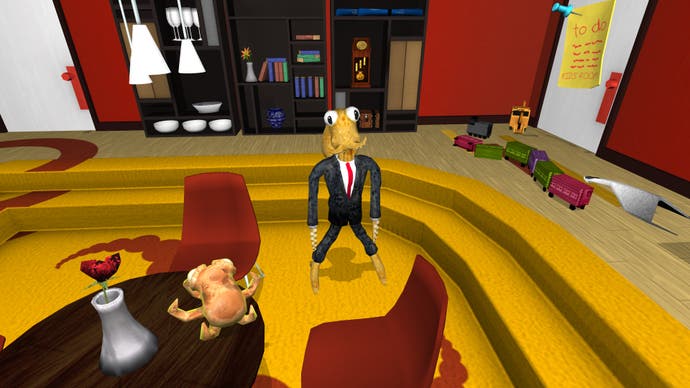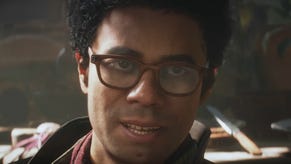We no longer have to be space marines
We can be goats instead.
Who do you want to be? A pilot gadding about in a giant mech? A magical lady in a complex, zip-heavy outfit? An abstract claw racing around the edges of a bright, vectorish grid? How about a goat?
This is your choice if you like video games and you've been looking at Eurogamer this week. It covers Titanfall, Final Fantasy, TxK and Goat Simulator - and that's a selection that fills me with all kinds of happiness. Cast your gaze only a little further back and you get Octodad, in which you play as a clumsy cephalopod trying to blend in with humans, and Catlateral Damage, which pretty much speaks for itself.
So, yes: who do you want to be? It's a question that mainstream gaming has often struggled to ask players over the last few hardware cycles. Or rather, it's struggled to provide more than a handful of answers. It's become a truism that big budget designers have a hard time stepping away from tried and tested ideas like the man-with-a-gun set-up, but as with many truisms, it's often - y'know - true. A couple of years back, I remember working on an issue of a mag that had four different games on the cover. Four men and, inevitably, four guns. Space Marine Syndrome - nestled in beside Wizard Syndrome, Lady-with-Sword Syndrome, Fatigues-and-M16 Syndrome: it all felt so natural at the time, so hopelessly ingrained. It felt like this was never ever going to change. Look at some of the games we've been talking about over the last few months, though. It has changed. What's happened? And is it going to last?

In a way, it feels like we've found a secret portal back to the past - back before the steel shutters of genre descended with a terrifying slam, before every game was an FPS, or an RPG, or an RTS, or an MMO FPS with RPG elements and RTS-styled PvP. Back before games were all about the TLAs, they could be about anything. You're a frog that can do magical anagrams, you're a guy riding an ostrich. They could be entirely abstract, because they often had to be entirely abstract, and they could include any kind of mechanics imaginable, because the money people had yet to truly focus on the handful of mechanics that brought in the most cash.
Coming out of triple-A development in the last few years, it must have been appealing to look back on those games - to look back on days where you wouldn't be just one of 400 people working on a project, doing nothing but the haircuts or the rust on the vents in a spaceship's corridors. It must have been appealing to look back on games where all sorts of ideas were up for grabs, and where a range of different art approaches meant you weren't stuck with making the kind of beautiful and expensive lunges at photo-realism that inevitably became a lot less beautiful and expensive-looking with every passing month. Titanfall is pretty dazzling at the moment, but so is a screenshot of Asteroids, which was released almost 35 years ago, and which will still look amazing 35 years from now?
When it comes to variety, the indies are a big part of the answer, then, but is the situation a bit more nuanced than that? I think games like Octodad and Goat Simulator suggest that it is. They suggest, rather perversely, that the reason we're suddenly getting a wider range of gaming protagonists - a wider range of gaming subject matter - might ultimately be because of changes in technology. The twist is, it's changes in the technology that surrounds games as much as the technology that directly powers them.

Let's take Octodad first. Octodad was a student project originally, and in its energy, its breezy weirdness, you can still see traces of that. I'm going to lump student projects together with stuff like Double Fine's Amnesia Fortnights here, because they're all, ultimately, prototypes. Design teams have always made prototypes, but up until recently the only people who got to see them were the greenlight people at publishers. Publishers tend to be thinking about returns. This is laudable, of course, but it makes them cautious - and cautious publishers often bet on space marines.
Two things have changed of late. One thing is the arrival of cheap middleware that means all sorts of people can now make prototypes. Barely a day goes by at the moment where I don't load up something new and bizarre-sounding, only to be greeted by the Unity logo, for example. The other thing is distribution platforms that mean you can get your prototype out to a lot of people very quickly. You can do a Minecraft - this is now called doing an Early Access, I guess - and while, if you're like me, you probably have mixed feelings about the rush towards Early Access as a business model, it's worth remembering that it's already given us some amazing stuff. It's given us games that have the off-the-cuff energy and footloose subject matter of a prototype, and games that have a greater chance of holding onto their energy as the audience provides feedback during development. I want a game that's polished and finished, but that's also filled with the dynamism of an initial design. I want a painting with the soul of a napkin sketch, and that's what Early Access can sometimes give me.
Actually, three things have changed. Cheap middleware and digital distribution handle making your game and getting it out to people, but how do you raise awareness? Here's where I turn to Goat Simulator - a game that is ideally suited to the likes of Upworthy, of Buzzfeed, of any one of those other services that inject wacky/maudlin/listy/I-can't-believe-this stories into your Facebook feed. Viral stories and videos aren't just creating the odd breakout gaming hit, they may also ultimately change the way a lot of games get made.

Suddenly, getting a nutty idea, realising it relatively cheaply, and pinning your sales hopes and the project's future on virality - on word-of-mouth - must seem like a pretty good notion. Inevitably, the tail will start to wag the dog and we'll get games that exist because they're viral-friendly. A game about goats, a game about an octopus, a game about surgeons - these insane ideas could actually be a much smarter move in the era of sharing than playing it safe, sticking to a tried-and-tested genre, and then hoping that your marketing and PR is somehow better than everyone else's marketing and PR and that you stand out from the seemingly identical crowd. Suddenly, your whole business plan revolves around people saying, "I can't believe they made a game about X," and then passing it on to their friends, who also can't believe it - and who also might pass it on, or do a Let's Play. Somewhere along the line, you'll possibly find the people you were looking for: people willing to take a punt on something a bit different.
The safe games aren't as safe as they used to be, in other words, and the risky successes are making games richer because they are, by their nature, more vivid and more unexpected. Fewer, bigger bets has been the mantra of the larger publishers for the last few years, and I don't necessarily see that changing anytime soon. But for developers, smaller, crazier, more frequent bets might increasingly be the clearer path ahead. We're going to get a lot of junk from such a strategy, and we're going to get a lot of Early Access games that are actually just fishing expeditions. But we're also going to get Octodads, Goat Simulators and other glittering oddities that prove there's a vivid gaming life to be lived beyond the thudding footsteps of those space marines.



-3-31-23-screenshot.png?width=291&height=164&fit=crop&quality=80&format=jpg&auto=webp)





